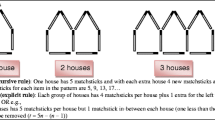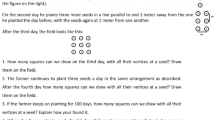Abstract
National curriculum guidelines advise teachers to begin algebra with the study of patterns leading to their description as algebra rules relating two variables. Traditional approaches are based on the use of algebraic letters to stand for specific but unknown numbers. In this paper we show that a pattern-based approach does not automatically lead to better understanding of functional relationships and algebraic rules. Approximately 1200 students in Years 7 to 10 in 10 schools were tested on recognising, using and describing rules relating two variables. Fourteen students were interviewed. Students saw a variety of patterns, many of which were not helpful for algebra. The critical steps in moving from a table to an algebraic rule are outlined.
Similar content being viewed by others
References
Australian Education Council (1991).A national statement on mathematics for Australian schools. Carlton, Vic: Curriculum Corporation.
Blane, D., & Booth, L. (1991).Moving through maths. Year 7. North Blackburn, Vic: Collins Dove.
Booth, L. (1984).Algebra: Children’s strategies and errors. A report of the Strategies and Errors in Secondary Mathematics Project. Windsor, Berks: NFER-Nelson.
Department of Education and Science (1991).Mathematics in the National Curriculum. London: HMSO.
Hart, K. (1981). Ratio and proportion. In K. Hart (Ed.),Children’s understanding of mathematics: 11-16 (pp. 88–101). London: Murray.
Lowe, I., Johnston, J., Kissane, B., & Willis, S. (1993).Access to algebra. Book 1. Carlton, Vic: Curriculum Corporation.
Lowe, I., & Lovitt, C. (1984).RIME lesson pack (Part B). Melbourne: Curriculum Branch, Education Department of Victoria.
MacGregor, M., & Stacey, K. (1992). A comparison of pattern-based and equation-solving approaches to algebra. In B. Southwell, K. Owens & B. Perry (Eds.),Proceedings of Fifteenth Annual Conference of the Mathematics Education Research Group of Australasia (pp. 362–371). Brisbane: Mathematics Education Research Group of Australasia.
MacGregor, M., & Stacey, K. (1993a). Cognitive models underlying students’ formulation of simple linear equations,Journal for Research in Mathematics Education, 24(3), 217–232.
MacGregor, M., & Stacey, K. (1993b). Seeing a pattern and writing a rule. In I. Hirayabashi, N. Nohda, K. Shigematsu & F. -L. Lin (Eds.),Proceedings of the Seventeenth International Conference for the Psychology of Mathematics Education (pp. 181–188). Tsukuba, Japan: International Group for the Psychology of Mathematics Education.
McLeod, J., Ganderton, G., Creeley, T., & Tanti, L. (1988).Mathematics for Australian schools. Year 7. South Melbourne; Macmillan.
National Council of Teachers of Mathematics (1989).Curriculum and evaluation standards for school mathematics. Reston, VA: National Council of Teachers of Mathematics.
Pegg, J., & Redden, E. (1990). Procedures for, and experiences in, introducing algebra in New South Wales.Mathematics Teacher, 83(5), 386–391.
Quinlan, C., Low, B., Sawyer, T., & White, P. (1989).A concrete approach to algebra. Sydney: Mathematical Association of New South Wales.
Schnabl, G., Schnabl, L., & Wagstaff, D. (1985).7 plus. A mathematics textbook for year 7. Melbourne: Longman Cheshire.
Stacey, K. (1987). Children’s informal mathematics: Building on strengths and identifying weaknesses. In W. Caughey (Ed.),From now to the future (pp. 85–89). Melbourne: Mathematical Association of Victoria.
Stacey, K. (1989). Finding and using patterns in linear generalising problems.Educational Studies in Mathematics, 20, 147–164.
Stacey, K., & MacGregor, M. (in press). Building foundations for algebra.Mathematics Teaching in the Middle School.
Tomlinson, P., Ardley, J., Mottershead, L., Thompson, A., & Wrightson, E. (1987).Mathematics today. Year 7. Sydney: McGraw-Hill.
Author information
Authors and Affiliations
Rights and permissions
About this article
Cite this article
MacGregor, M., Stacey, K. The effect of different approaches to algebra on students’ perceptions of functional relationships. Math Ed Res J 7, 69–85 (1995). https://doi.org/10.1007/BF03217276
Issue Date:
DOI: https://doi.org/10.1007/BF03217276




